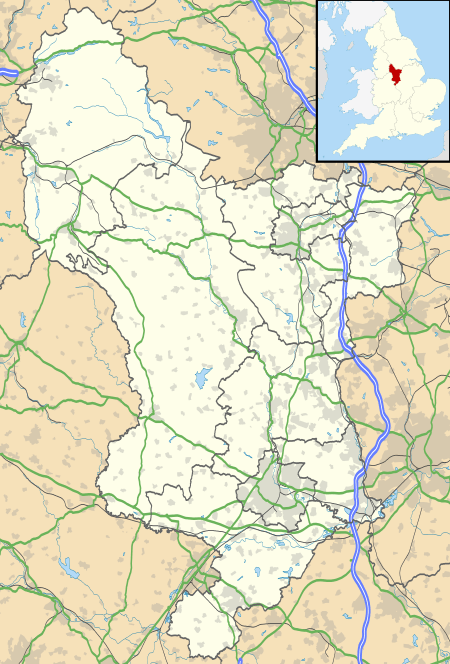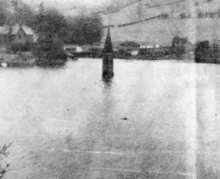Derwent, Derbyshire
Derwent is a village 'drowned' in 1944 when the Ladybower Reservoir in Derbyshire, England was created. The village of Ashopton, Derwent Woodlands church and Derwent Hall were also 'drowned' in the construction of the reservoir.
| Derwent | |
|---|---|
 Remains of the village exposed in 1995 | |
 Derwent Location within Derbyshire | |
| Population | 51 (2001) |
| District | |
| Shire county | |
| Region | |
| Country | England |
| Sovereign state | United Kingdom |
| Post town | HOPE VALLEY |
| Postcode district | S33 |
| Dialling code | 01433 |
| Police | Derbyshire |
| Fire | Derbyshire |
| Ambulance | East Midlands |
| UK Parliament | |
Preparations and creation of reservoir
All buildings in the village had been demolished by autumn 1943, and the impounded waters of the reservoir began to rise by the end of 1944.
Derwent's packhorse bridge spanning the River Derwent near the main gates of Derwent Hall was removed stone by stone to be rebuilt elsewhere as it was designated a monument of national importance.

The church held its last service on 17 March 1943.[1] The bell from the church may still be heard in Derbyshire, however, since it was re-hung in St Philip's Church in Chaddesden, built in 1955. Bodies from the graveyard had been exhumed in 1940 and were reburied in the village of Bamford.[2] The church spire was left intact to form a memorial to Derwent. However, it was dynamited on 15 December 1947, on the rationale of safety concerns.
Remains of the village
The site of the village has been revealed when the reservoir levels fell dramatically in 1976, 1989, 1995, 2003 and 2018.
In 2018, the appearance of the village due to low water levels caused unprecedented crowds to visit the rarely visible site. On 3 November 2018 a man had to be rescued by a mountain rescue team after getting stuck in extremely thick mud around the ruins of the village.[3] On 17 November 2018 it was reported that the site had been vandalised by some of those visiting, with park rangers forced to stop visitors removing items from the site and with graffiti scrawled on some buildings.[4]
Despite being flooded, a few houses survive above the waterline, and there remains a civil parish of Derwent. At the time of the 2001 UK census, it had a population of 51. At the 2011 Census the population remained less than 100. Details were included in the civil parish of Aston, Derbyshire.
The most significant surviving reminder of Derwent Village is the village's packhorse bridge, painted in 1925 by the artist Stanley Royle. The bridge was transported and rebuilt at the head of Howden Reservoir at Slippery Stones where it now forms part of the paths and cycle tracks around the Derwent Valley reservoirs.[5] The Derwent Valley Museum, formerly[6] located on the Derwent Reservoir dam and run privately by the late Vic Hallam, told the history of the Derwent valley and of Derwent and Ashopton as well as the tale of RAF Squadron 617 ("The Dam Busters") and its training for Operation Chastise during the Second World War.[7]
There is no formal memorial to any of the villages. However, the site of the construction workers' temporary village when the higher Derwent and Howden Reservoirs were built is clearly marked by a plaque. The only marker of the location of Derwent is the village's War Memorial which stands above Ladybower Reservoir at a point to the west of the village.
Notable residents
- Charles Balguy was born at Derwent Hall in 1707.[8]
See also
| Wikimedia Commons has media related to Derwent, Derbyshire. |
- List of places in Derbyshire
- Capel Celyn (similar village 'drowned' to create a reservoir)
References
- Hallam, Vic (1989). Silent Valley: The Story of the lost Derbyshire villages of Derwent and Ashopton. Sheffield: Sheaf Publishing. ISBN 0-9505458-9-9.
- "Old photos and postcards of Derwent Village in Derbyshire". Retrieved 20 April 2020.
- "Low water levels reveal abandoned village". BBC News. 17 November 2018. Retrieved 25 November 2018.
- "Rarely seen abandoned village vandalised". BBC News. 25 November 2018. Retrieved 25 November 2018.
- "Packhorse Bridge, Derwent, Derbyshire". Art UK. Retrieved 25 June 2016.
- Dodds, Jonathan (13 January 2019). "Dambusters museum in the works for Derbyshire - here's where". Derby Telegraph. Retrieved 20 April 2020.
- "Derwent Dam Museum". Derwent Dam Museum. 2012. Archived from the original on 2 July 2012. Retrieved 1 May 2014.
- "Balguy, Charles". Oxford Dictionary of National Biography (online ed.). Oxford University Press. doi:10.1093/ref:odnb/1200. (Subscription or UK public library membership required.)